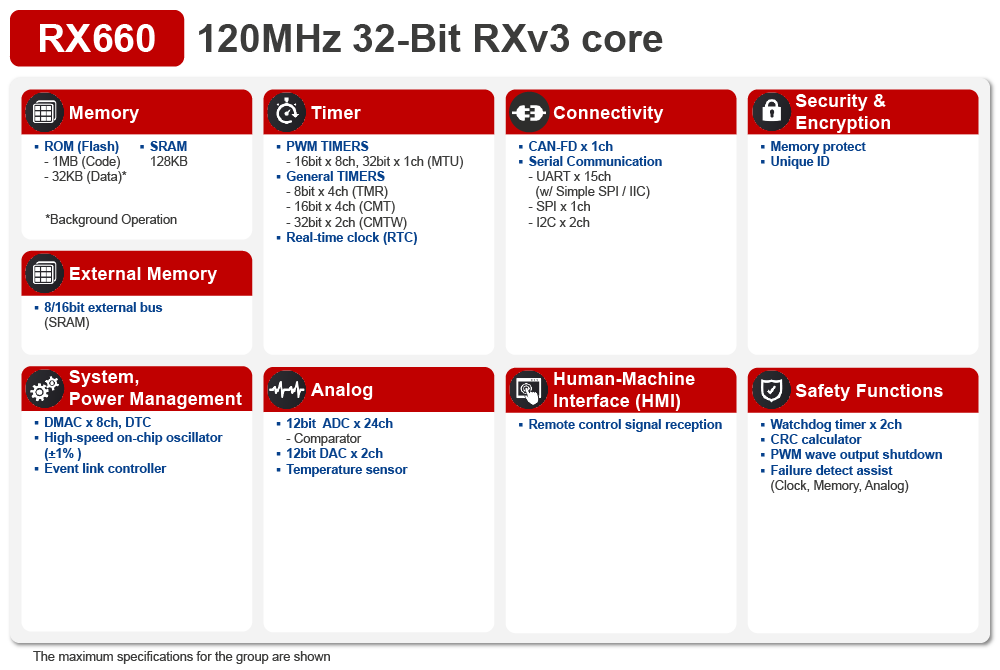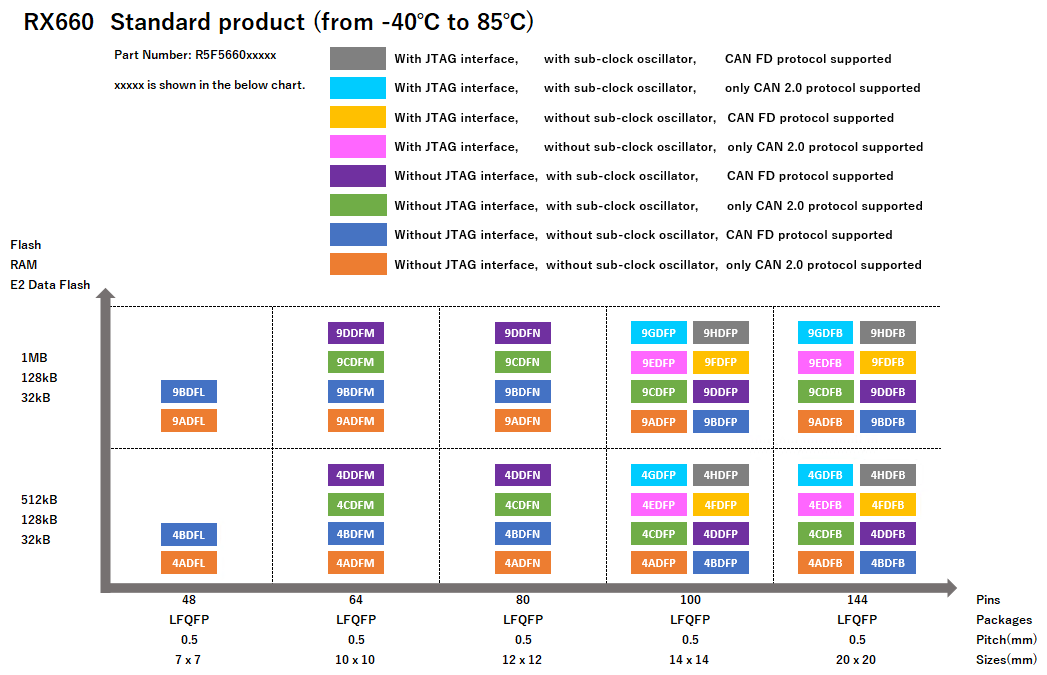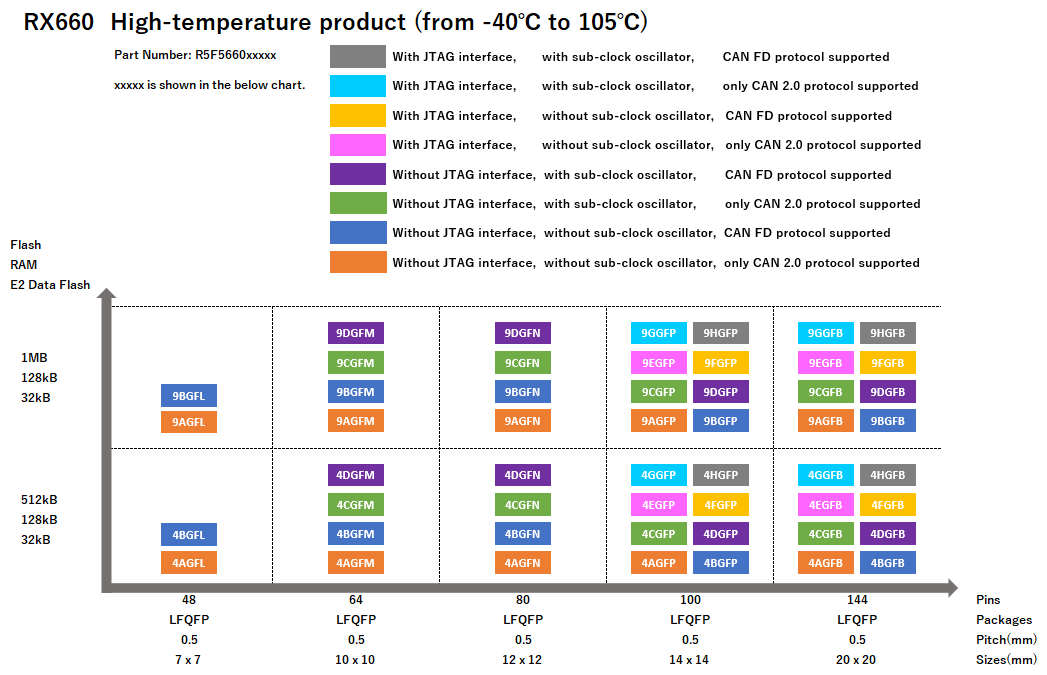Overview
Description
The RX660 Group is the first 5V-compatible product among the RX600 and RX700 high-end general-purpose microcontrollers. With this 5V support, it gives excellent noise tolerance and does not require any external coils for noise suppression, which contribute to the reduction of the overall system cost. The RXv3 core operates at 120 MHz with no wait access to the flash memory, resulting in stable arithmetic processing and achieving excellent real-time performance. The number of effective general-purpose IO pins has been increased by approximately 10% from the previous 5V-compatible RX210, enabling an increase in the number of sensors that can be connected with the same package, contributing to easier system upgrades. For peripheral functions, this is the first in the RX series to incorporate CAN FD, enabling the implementation of next-generation networks such as industrial networks. Furthermore, HOCO oscillation accuracy of 1.0% can be guaranteed in a high-end product for the first time, enabling a reduction in external oscillators and contributing to lower system costs. A wide range of customer platform development can be handled with a single chip with a LFQFP package lineup ranging from 48-pin to 144-pin, and featuring up to 1MB flash memory and 128KB SRAM. This easily improves the performance and expands the functionality of home appliances and industrial equipment.
Features
- Wide operating voltage range of 2.7 to 5.5V
- 120MHz RXv3 CPU core on-board (721CoreMark)
- Single-precision FPU, batch register save function for faster interrupt response, trigonometric function accelerator (TFU)
- Up to 1MB flash memory (120MHz read access) and 128KB SRAM
- 32KB data flash that can store data like an EEPROM
- Pin layout is compatible with existing RX products, peripheral function compatible
- +/-1.0% accuracy high-speed on-chip oscillator
- CAN FD (ISO 11898-1:2015 standard)
- Infrared remote control receiver circuit
- SCI (up to 13 ch) supporting a variety of communication functions
- SCI (up to 2 ch) with 16-byte transmit/receive FIFO
- I2C bus interface (RIICa) (2 ch)
- RSPI (1 ch) up to 30 Mbps transfer
- 16-bit general-purpose PWM timer (complementary PWM output possible)
- 12-bit A/D converter (1 unit: 24 ch), 12-bit D/A converter (2 ch), comparator (4 ch)
- Real-Time Clock (RTC)
- Diverse package lineup from 48 to 144 pins
- Up to 134 general-purpose I/O ports
Comparison
Applications
Design & Development
Software & Tools
Sample Code
Boards & Kits
Models
ECAD Models
Schematic symbols, PCB footprints, and 3D CAD models from SamacSys can be found by clicking on the CAD Model links in the Product Options table. If a symbol or model isn't available, it can be requested directly from SamacSys.

Support

Support Communities
Support Communities
-
RX660 TMR0 ... TMR3
Hello I am trying to configure any one of the 8bit timers TMR0 ... TMR3 in Configurator and cannot set the timer period to be what I need. I am looking for a 1mS timer and set configurator as follows : Clock source PCLK/1024Counter clear DisabledCompare match A value(TCORA ...
Jan 1, 2023 -
RX660 User Boot Mode | Error: call to undefined function '_r_flash_control'
Hello everyone,I am working on accessing User Boot mode on the RX660 chip to implement a bootloader program for my project. According to the manufacturer’s documentation, there are 32 kbytes allocated for the User Boot memory, located at the address range (0xFF7F8000 - 0xFF7FFFFF). I have modified the linker ...
Nov 29, 2024 -
RX660 PINs
Hello I am using the RX660 (100pin QFP) and on the document R01DS0393EJ0100 Rev.1.00 on page 43 PIN76/PE2 can be used as RX12 and PIN77/PE1 can be used as TXD12 yet when I add SCI communication module using the Smart Configurator and select SCI12 ...
Dec 24, 2022
FAQs
-
Sample software
The following sample software is provided. Target Board for RX660 LED Lighting Control Program (R20AN0658) Renesas Starter Kit for RX660 LED Lighting Control Program Initial Register Setting Program (R01AN6015)
Aug 2, 2022 -
How to set input order of ID codes for authentication in each tool of RX Family Groups
Input orders of ID codes are different for each device and tool.Please refer to the table below. RX Family Tool The input order of ID codes RX72T, RX72N, RX72M, RX71M, RX671, RX66T, RX66N, RX660, RX65W-A, RX65N, RX651, RX64M, RX26T Renesas Flash Programmer Enter the values sorted by ID ...
Jan 1, 1970 -
Function differences by product model name
Refer to “1.2 Product List” in the hardware manual. Caution: The product model name differs depending on whether or not the JTAG, SubOSC, and CANFD functions are available, so select a model name according to the functions to be used. In addition, the model name differs depending on the ...
Aug 2, 2022
Videos & Training
This video explains the newly designed RX660 voice recognition solution, including board information, relevant tools, and evaluation results in an environment that appears in daily life.




